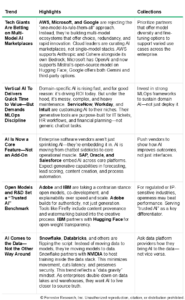Transforming Enterprise Business Apps With Powerful AI Ecosystems And Marketplaces
We can’t emphasize enough the importance of interconnected networks and ecosystems to the enterprise application software market. Industry cloud providers and hyperscalers possess several key advantages in nurturing and leading these innovation networks. So what does this acceleration of AI software and services on industry cloud and hyperscaler marketplaces mean? Well, it depends on the customer segment the providers are vying to attract.
Enterprises are driven by strategic advantages, risk mitigation, maximizing the value derived from their AI investments, improving data locality, and reducing latency — all while prioritizing optimizing costs and operational performance.
Independent software vendors (ISVs) are driven by a unique set of business and strategic goals that focus on building trust and meeting customer requirements while protecting their IP and mindshare.
For regulated industries, because these ecosystems often involve third-party vendors and cloud platforms, the vetting of AI partners and solutions requires a heightened level of scrutiny. The desire for AI sovereignty is much stronger than a policy concern — it must comply with strict legal mandates and AI-specific legislation such as the EU AI Act; this is critical for national security and economic interests. They are driven by the control over key enablers of AI development, deployment, and the implications of global access and collaboration.
What do all the stakeholders have to gain from enterprise software markets operating within these massive ecosystems?
For Enterprises
- Increased accessibility to advanced AI capabilities. Enterprises gain easier access to a wide array of cutting-edge AI tools and services without the need for significant upfront investment in infrastructure or specialized AI expertise. Hyperscalers’ marketplaces offer pretrained models, machine learning platforms, and AI-powered services for various applications — all of which can be procured through committed cloud spend, cutting out vendor onboarding cycles. For example, a B2C company can readily access AI-powered recommendation engines on a hyperscaler marketplace to personalize customer experiences and increase sales after a “try before you buy” proves its value.
- Cost optimization. Pay-as-you-go (PAYG) pricing models can lead to cost savings compared to building and maintaining in-house AI infrastructure, but cloud migration efforts may still require upfront investments that can sometimes be offset or spread over time. Once you modernize with the cloud, enterprises can scale their AI usage based on actual needs and pace implementations that align with strategic priorities. Do beware, however, that mature governance is required to mitigate both buyer and provider challenges with the PAYG licensing model. If one software product isn’t paying off as expected, it’s easy enough to find an alternative on the marketplace and “recompose” your stack to adopt it.
For ISVs
- Simplified go-to-market strategies. These marketplaces allow small ISVs to be part of integrated billing, procurement, logistics, and marketing tools, simplifying the way ISVs offer their AI-powered software and services to a wider audience, leveraging hyperscaler capabilities, and managing multiple listings across marketplaces.
- Highly scalable infrastructure capabilities. ISVs can build their solutions on top of highly scalable infrastructure, enhancing the performance and scalability of their offerings while focusing on their unique industry expertise.
- Faster innovation through integration. ISVs can integrate their AI solutions with other services available on the marketplaces, creating more comprehensive and valuable offerings for customers. This is quite valuable for the enterprise business application market. Even with their horizontal growth strategies, enterprise software continues to have persistent challenges with: 1) integration across apps with dependent functional capabilities; 2) interoperability with crucial business workflows; and 3) end user adoption — whether it’s a lack of consumer-grade experiences or the expectation of intuitive engagement. The adage “We’re essentially paying Cadillac prices for a Ford Pinto experience” continues to circulate corporate meeting rooms.
ISVs, this is your opportunity to leverage these marketplaces and ecosystems to develop AI models and create AI solutions that address these challenges — making your solutions a critical asset to organizations for deploying enterprise solutions at scale.
For Regulated Industries
- Focus on specific industry needs. Industry clouds are tailored to meet the unique compliance, security, and operational requirements of regulated sectors such as government and healthcare, providing a trusted environment for deploying AI solutions. Ensuring ethics and AI sovereignty in government is a highly contentious and complex debate. New options continue to shape the landscape, but no one is dominating the headlines yet.
- Force much-needed attention to governance, transparency, and risk mitigation. Traditional enterprise business applications faced the “black box” problem even before AI’s unique challenges amplified the complexity of governance and risk mitigation. Users didn’t understand the internal workings of the software; debugging and problem resolution were challenging; and third-party libraries and closed-source components had limited visibility. While modern platform ecosystems expedite procurement and deployment, they inadvertently introduce complexities around data governance, model oversight, and IP protection. These accelerated networks are forcing organizations to move faster and enter the market with stronger governance. Additionally, strict contractual clauses around vendor accountability and breach notifications are crucial for meeting compliance requirements and holding the vendors accountable to those commitments.
- Maximize interoperability and data sharing (with safeguards). AI can facilitate secure and compliant data sharing and interoperability across different agencies or healthcare providers, leading to better insights and more coordinated services.
Pay Attention To The Ecosystem Trends That Reshape The Business Landscape
These trends present both opportunities and challenges that can significantly impact organizations’ strategies and long-term success.

Let’s Connect
Continue the conversation with our analysts who focus on enterprise business applications, industry cloud, and hyperscalers: Faram Medhora, Kate Leggett, Akshara Naik Lopez, Joe Cicman, Tracy Woo, and Bill Martorelli.
Relevant Research
- Deciphering The Hyperscalers’ GSI Partner Programs
- Use The EU AI Act To Start Your Trustworthy AI Journey
Thank you to the following analysts for contributing to this blog: Kate Leggett, Bill Martorelli, and Joe Cicman.
